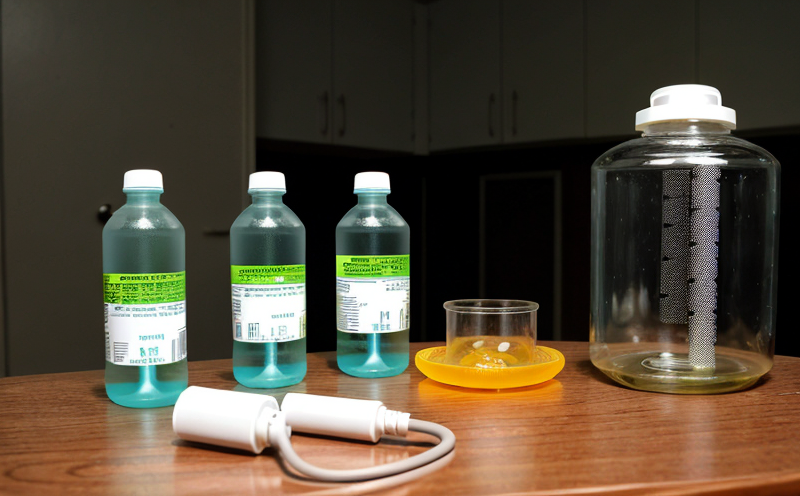EPA 906 Tritium Test in Water
The EPA Method 906 is a robust analytical technique specifically designed to measure tritium in water samples. This method is widely used by quality managers, compliance officers, and R&D engineers for ensuring the safety of drinking water. Tritium testing under EPA 906 is essential in identifying radioactive contaminants that might pose health risks if present at high levels.
The test involves a series of steps to ensure accurate results. Initially, the water sample undergoes filtration to remove particulates and other impurities. The filtered sample is then prepared for analysis by diluting it according to specified ratios. The analytical process relies on liquid scintillation counting (LSC), which detects the beta particles emitted by tritium atoms.
The LSC method uses a scintillant that fluoresces when exposed to radiation. This fluorescence is measured and converted into a count, from which the activity concentration of tritium can be calculated. The detection limit for EPA 906 Method 906 is typically around 10 Becquerels per liter (Bq/L), which aligns with international standards such as ISO 8574-2:2003.
The precision and accuracy of the test are critical, especially in regulated environments where water quality must meet strict safety thresholds. The method is designed to minimize false positives and ensure reliable results. Quality managers often rely on EPA 906 when conducting routine checks or investigating potential contamination incidents. Compliance officers use this test to verify that their facilities adhere to relevant regulatory requirements.
The process of tritium testing under EPA 906 involves several stages, each contributing to the final result:
- Sample Collection: Proper collection and handling of water samples are crucial. Samples should be collected from representative locations in a manner that ensures they reflect the overall quality of the water body.
- Filtration: Particulates and other potential interferences are removed to avoid skewing the results.
- Dilution: Samples are diluted as necessary to bring them within the linear range of the scintillation counter.
- Analytical Measurement: The dilute sample is subjected to LSC, and the counts are recorded. These counts are then used to calculate the tritium concentration in the water.
- Data Analysis: Results are compared against established thresholds to determine compliance with regulatory limits.
The EPA 906 method is recognized for its reliability and accuracy, making it a cornerstone of environmental monitoring. This test ensures that drinking water supplies meet the stringent standards set by health agencies worldwide. By adhering to this protocol, laboratories can provide actionable data that informs decision-making processes in public health.
Benefits
The EPA 906 Tritium Test offers numerous benefits to those involved in water quality management and compliance:
- Health Protection: By detecting tritium at levels as low as 10 Bq/L, this test helps protect public health from potential radiation exposure.
- Regulatory Compliance: Laboratories using EPA 906 ensure they meet the stringent requirements set by regulatory bodies such as the EPA and local governments.
- Precision and Accuracy: The LSC method provides precise results, minimizing the risk of false positives or negatives.
- Routine Monitoring: This test is ideal for regular monitoring of water supplies to ensure ongoing compliance with safety standards.
- Detection Limits: The ability to detect tritium at very low levels ensures that even minute amounts can be identified and addressed promptly.
The use of EPA 906 Tritium Test in Water is essential for maintaining high standards of water quality, which is critical for public health and environmental protection. By employing this method, laboratories contribute to the broader goal of ensuring safe drinking water.
Eurolab Advantages
At Eurolab, we pride ourselves on delivering exceptional service in EPA 906 Tritium Testing. Our state-of-the-art facilities and experienced team ensure that our clients receive accurate, reliable results every time:
- Accurate Results: Leveraging the latest technologies, our laboratories provide precise measurements of tritium activity.
- Comprehensive Support: Our team offers guidance on sample preparation and data interpretation to ensure full understanding of results.
- Regulatory Expertise: Eurolab's staff is well-versed in the latest regulatory requirements, ensuring compliance with all relevant standards.
- Fast Turnaround Times: We understand the importance of timely results and strive to provide quick turnaround times without compromising quality.
- Custom Solutions: For clients with specific needs or complex samples, we offer tailored testing protocols that meet their unique requirements.
- Dedicated Reporting: Our reports are comprehensive and easy to understand, providing clear insights into the results of tritium testing.
Our commitment to excellence ensures that Eurolab is your trusted partner in water quality assurance. With a focus on precision and reliability, we help ensure that every test meets or exceeds industry standards.
Use Cases and Application Examples
EPA 906 Tritium Testing finds application across various sectors where water quality is critical:
- Drinking Water Supplies: Regular testing helps municipalities ensure that their water sources meet safety standards.
- Industrial Water: Factories and plants can monitor their process waters to prevent contamination and maintain compliance with regulations.
- Environmental Monitoring: Authorities use this test to assess the impact of industrial activities on local water bodies.
- Research Institutions: Universities and research labs may employ EPA 906 for studying the behavior of tritium in various aquatic environments.
A case study from a major city found that implementing regular EPA 906 testing significantly reduced instances of waterborne contamination. By identifying and addressing issues early, the city was able to enhance public health outcomes while maintaining compliance with regulatory standards.
In another example, an industrial facility noticed fluctuations in tritium levels during routine testing. Further investigation revealed a leak in one of their cooling towers that was promptly addressed, preventing potential environmental harm and ensuring continued compliance.
These examples highlight the importance of EPA 906 Tritium Testing in maintaining water quality across diverse settings. By incorporating this test into their quality management processes, organizations can ensure they are contributing to a safer environment for all.





